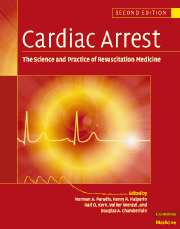Book contents
- Frontmatter
- Contents
- List of contributors
- Foreword
- Preface
- Part I Introduction
- Part II Basic science
- Part III The pathophysiology of global ischemia and reperfusion
- Part IV Therapy of sudden death
- Part V Postresuscitation disease and its care
- 47 Postresuscitation syndrome
- 48 Prevention and therapy of postresuscitation myocardial dysfunction
- 49 Prevention of postresuscitation neurologic dysfunction and injury by the use of therapeutic mild hypothermia
- 50 Postresuscitation neurologic prognostication and declaration of brain death
- 51 Bringing it all together: brain-oriented postresuscitation critical care
- Part VI Special resuscitation circumstances
- Part VII Special issues in resuscitation
- Index
47 - Postresuscitation syndrome
from Part V - Postresuscitation disease and its care
Published online by Cambridge University Press: 06 January 2010
- Frontmatter
- Contents
- List of contributors
- Foreword
- Preface
- Part I Introduction
- Part II Basic science
- Part III The pathophysiology of global ischemia and reperfusion
- Part IV Therapy of sudden death
- Part V Postresuscitation disease and its care
- 47 Postresuscitation syndrome
- 48 Prevention and therapy of postresuscitation myocardial dysfunction
- 49 Prevention of postresuscitation neurologic dysfunction and injury by the use of therapeutic mild hypothermia
- 50 Postresuscitation neurologic prognostication and declaration of brain death
- 51 Bringing it all together: brain-oriented postresuscitation critical care
- Part VI Special resuscitation circumstances
- Part VII Special issues in resuscitation
- Index
Summary
The postresuscitation syndrome (PRS) has been defined as a condition of an organism resuscitated following prolonged cardiac arrest, caused by a combination of whole body ischemia and reperfusion, and characterized by multiple organ dysfunction, including neurologic impairment.
Background
Following resuscitation from cardiac arrest, patients either recover consciousness or remain unconscious, depending on the duration of cardiac arrest and the effectiveness of any CPR, but also on prearrest conditions such as age and comorbidities.
Shortening no-flowtimes by timely interventions that can maintain some perfusion and promote the restoration of spontaneous circulation (e.g., bystander CPR, early defibrillation, and other means) improves the possibility of a successful outcome with the patient recovering consciousness.
The wider availability of resuscitation techniques to reverse clinical death, however, has led to increasingly frequent observations of a pathological condition occurring in patients who remain unconscious, involving multiple organ injury or failure following reperfusion after prolonged cardiac arrest.
The concept of postresuscitation disease as a unique and new nosological entity was introduced by Negovsky in 1972; the most interesting aspect of this innovative concept was the recognition that the etiology depended on a combination of severe circulatory hypoxia with the unintended sequelae of measures used for resuscitation.
On the basis of the wide variety of ischemic/hypoxic mechanisms that can trigger its development, the disease was redefined by Safar as a syndrome in which pathogenetic processes triggered by cardiac arrest were exacerbated by reperfusion, causing damage to the brain and other organs, the complex interactions of which combine to determine overall outcome (see early experimental findings summary).
- Type
- Chapter
- Information
- Cardiac ArrestThe Science and Practice of Resuscitation Medicine, pp. 817 - 828Publisher: Cambridge University PressPrint publication year: 2007



